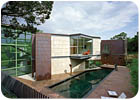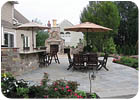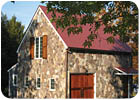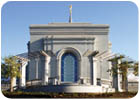
Although the use of stone for exterior applications dates back centuries, it is still a common practice today. The material is not only durable, but it contains a timeless appearance that is often desired for both residential and commercial designs. Additionally, stone can often aid in synchronizing a structure with its environmental surroundings. And more and more, choosing regional stone that is in close proximity to a project's site has become an important factor in material selection. Whatever the case, architects and designers continue to discover innovative ways to engage stone to its fullest potential.
Whether it means employing a stone traditionally seen on the exterior of a commercial property for a residential facade, or turning the outdoors of a private residence into a complete living space, stone is reaching new boundaries, according to architect Winn Wittman, AIA, of Winn Wittman Architecture in Austin, TX.
"I think people are pushing their limits with what stone can do," said Wittman. "There are new ways of putting stone together, and it's something that is always going to happen. It's a very ancient material, but there's always new ways to work with it. It's exciting."
Taking a Unique Approach
For a private residence in Austin, TX, the goal of conveying quality, validity and permanence would not have been made possible without the selection of stone for the exterior design, according to Wittman, who served as the lead architect for the project. Ultimately, it was decided to employ Texas shell stone throughout the exterior of the 6,100-square-foot home, which Wittman explained has fossils embedded in the stone.
"I've always loved that stone," he said. "I saw it first as a student at the University of Texas because many of the buildings there have it. It's amazing to look at with the fossils. To me that brings a timelessness to the architecture -- to have something that old with that much history that ages so well."
In keeping with the practice of local materials, Wittman also considered using an Austin Crème or Leuders limestone. The Texas shell stone, however, is what he found to be the most interesting to work with. "It was really nice to use this type of stone system on a residential project, which you normally would only find on a commercial [one]," he said.
For the home's facade, the pieces range from 1 1/2 x 2 to 2 x 4 feet, alternating in a square and rectangular pattern. Wittman revealed that the weight and size of the stone pieces posed difficulties. "It was very challenging setting stone of that scale," he said.
According to the architect, the pieces are held together in place by stainless steel clips and epoxy with the joints mortared for cosmetic reasons. "They're 2 inches thick, but we used a thick L-shaped piece at the corners to give a sense that the stone was much thicker than 2 inches," he said. "There was nothing easy about it, but it was all worth it."
Also visible throughout the outdoor area is a stairway comprised of Pink Arizona sandstone that leads to a 45-foot black granite and Pebbletec heated saltwater pool.
The project began design plans in 2003 with the completed construction done in 2007.
Public reactions to this project have amazed and overwhelmed Wittman. "It has already been published in more than 50 publications, featured as architectural house of the month in January and is making covers throughout," he said.
In regards to the homeowners, Wittman is also pleased for their sake with the way everything turned out. "I'm really glad I used this stone," he said. "I know the owner will be glad because it's going to continue to look beautiful for many years to come."

Outdoor Living
Stone also was a key component in capturing the essence of leisure and purpose for the backyard of a private residence in Mahwah, NJ. "The overall goal was to utilize as much space for entertaining and function for both the adults and children within the municipal standards," said Chris Cipriano, President of Cipriano Landscape Design in Ramsey, NJ, which served as the landscape designer and contractor for the project.
Cipriano further explained that the backyard, which prior to the new construction was just a flat area with a playground and deck, would now become a formal dining patio showcasing an outdoor kitchen, outdoor living room with a custom fireplace, a cabana with a surrounding patio and a swimming pool patio with coping and waterfalls.
From the beginning, it was decided that natural stone would be utilized throughout the design. Buechel Stone's Chilton Heritage Blend combined with a Chilton Cambrian with Sedona thin stone veneer was chosen for the outdoor kitchen, fireplace and the cabana, which occupied a space of 1,200 square feet. "The stone was selected for its versatility, color and characteristics," said Cipriano. He also added that, "all the walls, water tables and the fireplace were capped with 2-inch thermal topped Bluestone."
Pennsylvania Bluestone, chosen for its traditional characteristics, is also employed for the 2,100-square-foot space designated for the dining and cabana patios. Additionally, the same material was further applied as a thermal faced border in the 600-square-foot outdoor living room area, which also features 12- x 12-inch Bronte flagging.
Since the area being worked on would also be enjoyed by children, special consideration was put into the design of the 1200-square-foot swimming pool. "There's a lot of children in the neighborhood, so the homeowners wanted the place to be fun for them with a diving stone, a slide and swim shelf," said Cipriano.
For the patio surrounding the swimming pool, Irregular Grey Tennessee Crab Orchard stone was selected for its ability to remain cooler on hot days, according to Cipriano. He added the stone also complemented the natural waterfall surrounding, which consists of 120 tons of weathered fieldstone boulders -- weighing 2 to 16 tons each. "Each waterfall is done uniquely to the property and type of stone," said Cipriano.
In addition, the same fieldstone boulders are utilized throughout the landscape for slope retention and a handcrafted boulder campfire-style fire pit.
And finally, for the pool tile, a mosaic slate is featured on the waterline and the banding of all the steps, spa seating area and the sun shelf, which Cipriano explained added to the custom detailing of the swimming pool because of the stone's exclusive qualities.
Cipriano, who was on site daily for this project, managing the stonework himself, explained that the site presented many obstacles. "We had to remove 150 yards of organics which was buried where the main dining patio was going and then reinstall compactable fill in lifts to support the new patio slab," he said. "We also had to put 15 8-foot-deep pilings beneath the waterfall, spa and spa patio for support due to the soil instability caused by the high water table."
Despite the time spent in additional preparation, Cipriano feels it was all worth the effort to ensure the long-term enjoyment. "The family says they never leave the backyard," he said. "With these projects, the owners are already paying such high property taxes, so they want to not only extend the interior detail to the outside, but to also extend the use of the property from the early spring to well into the fall. They now have a truly balanced and functional backyard."
The project began construction in November 2006 and was completed in July 2007.

Remaining Traditional
When it came time for a private residence in Lake Anna, VA, to expand construction on its property, stone would again be used to create the facade of a guesthouse. The homeowner explained that the whole architectural concept was to create a Pennsylvania farmhouse look for his land.
"With Pennsylvania farmhouse architecture, usually what happens is that its structures are built over time and added on to," he said. "Many years ago, they would have a small detached house where they kept their carriages, so we wanted to build a guesthouse that looked like a carriage house."
And to make the guesthouse look authentic, Charles Burke, a custom builder from Lake Anna, VA, who specializes in building new things that are supposed to look old, was recruited for the project, according to the homeowner.
As part of keeping with the Pennsylvania farmhouse architecture, Pennsylvania fieldstone was selected at the Charles Luck Stone Center in Richmond, VA. "Traditionally, you only used what was available to you on the land where you were building your carriage house, which is why we went with a fieldstone versus a granite or a limestone," said the homeowner. Charles Burke followed by saying, "We picked through a lot of stone to get the look that we wanted."
There were clearly some challenges in achieving the classic Pennsylvania farmhouse look with a new structure, according to Burke. He explained that in the back of the carriage house there is a single-story shed addition, which makes for the different dimensions of the upper and lower level of the structure. The variation of the two dimensions however, did pose complexities, said the builder.
Other details requiring Burke's expertise were the metal roof, copper gutters and how both of these were incorporated with the stone on the exterior. The over 30-foot-tall chimney required additional thought for both the builder and the stonemason.
Another element requiring careful thought was the dry-stack stone-setting style, which resulted in a trial-and-error process. "Instead of a sample wall, we worked out the details right on the house," said the homeowner. "Shane Burnett, who is the Vice President of James River Exteriors, was very willing to let his masons put up a pattern, take it down and start over, which ultimately took three days to get right."
The carriage house, which began construction in July 2006 and was completed in January 2007, has been praised by its owners and others. "I'm amazed how well we all feel about the stonework and the quality," said the homeowner. "People insist to my wife that the carriage house on our property must be 100 years old. Charles and Shane were able to create that effect. It's fantastic."

Paying Attention to Details
The exterior stonework that comprises the facade of the Latter-Day Saints (LDS) temple as well as the lavish stone elements on the grounds is an example of true craftsmanship and teamwork. Bestview International Co. of Wood Dale, IL, the fabricator for the project, collaborated with Kepco+ of Salt Lake City, who installed the stone pieces. The stone drawings were provided by The Facade Group, LLC.
Work on the project -- located in the Sacramento area of California -- began in 2004, and the temple was completed in May of 2006. From the start, careful consideration was given to the design. Bestview International, with the assistance of Kepco+ and The Facade Group, created larger pieces for benches and newel post piers, which ultimately reduced on-site installation time and enhanced the overall aesthetics of the temple.
In total, 14,000 cubic feet of Temple White granite was employed for the project. Breaking it down further, 30,000 square feet was used for honed veneer panels, 6,000 square feet consisted of double-curved honed panels, 7,000 square feet was used to create straight and arched honed frieze pieces and 2,400 linear feet was cut into honed pieces that were employed for the door and window surrounds. Additionally, the temple is adorned with sandblasted moon-inspired medallions, which accent the frieze at the entrance arches of the building. There are also compass-shaped medallions created out of three granites -- Andrew Grey, Temple White and Xinjiang Red. The site work includes 27 pilasters, 300 balustrades, balustrade caps and trellis columns.
"Through the implementation of strict quality control measures when selecting the granite blocks, we were able to maintain a stability and color consistency throughout the project -- one of the factors contributing to its success," said Perry Liu of Bestview International. "Another factor that led to the success of the project was the construction of a mock-up that included many of the major stone details found on the building. The mock-up was built so that the design and construction team could view a section of the building large enough to get a feel for what the completed project would look like."
According to Liu, the mock-up was viewed by the team on their initial visit to Bestview's facility in China, and it helped to recognize and overcome obstacles and challenges that otherwise might not have been realized until the actual fabrication of the project. The mock-up also allowed the team to confirm and finalize the quality standards for the stone.
"Many challenges were encountered and overcome during the course of this project," said Liu. "Some of the major challenges included the fabrication of complicated details such as the radial walls, two-axis curved arches, trellis columns, arches with patterns changing at a spring-line block, etc. To help overcome these challenges and ensure the client was happy with the results, the methods of stone fabrication were a collaborative effort and closely monitored."
It is said that the Temple White granite gives the temple a rich California flavor that blends seamlessly with its native environment. Recently, the project was awarded an "Award of Merit" in the Marble Institute of America's Pinnacle Awards.